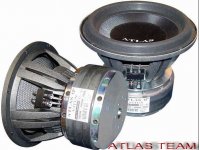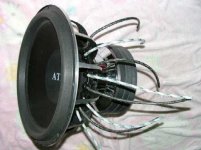does BL force factor parameter provide any useful information about speaker's performance? I noticed that high-end pro woofers have higher BL, and their sound is often described as more dynamic.
does it mean higher the BL the more dynamic driver is? or there is no direct relation.
does it mean higher the BL the more dynamic driver is? or there is no direct relation.
BL is simply the amount of force on the cone you get for a certain current through the voice coil. A higher Bl will make the driver play louder (but not necessarily cleaner) and it will also indirectly lower Qes and Qts.
Bl has to be viewed together with Re since it has the opposite effect. That is why the ratio Bl/sqrt(Re) is sometimes found in datasheets.
Bl has to be viewed together with Re since it has the opposite effect. That is why the ratio Bl/sqrt(Re) is sometimes found in datasheets.
Hi svante
Thia picture that i have ever seen. What do you think about this?
They want the spl or not?
regards
Thawach
______________________________________
The cheap materials and good engineering. Please believe
it's the garbages from good engineer. a salesman.
Thia picture that i have ever seen. What do you think about this?
They want the spl or not?
regards
Thawach
______________________________________
The cheap materials and good engineering. Please believe
it's the garbages from good engineer. a salesman.
Attachments
Hi svante
I ask you at 2007. and here is 2008. (about 1 year)
I cannot get the answer from you.😀
Are you sleeping? woo!
regards
😉
I ask you at 2007. and here is 2008. (about 1 year)
I cannot get the answer from you.😀
Are you sleeping? woo!
regards
😉
Hi svante
I would like to know that they make it for?
If you are not answer me. I will download The adge and Basta
to use.😀
2009?
Thanks
I would like to know that they make it for?
If you are not answer me. I will download The adge and Basta
to use.😀
2009?

Thanks
Hi
i want to know that it's difference from single magnet.
I see the picture . it has magnet to join=3.
the gap is long. i would like to know what the parameter change?
is it good idea?
regards
😉
i want to know that it's difference from single magnet.
I see the picture . it has magnet to join=3.
the gap is long. i would like to know what the parameter change?
is it good idea?
regards
😉
Hi
I understand all the words of yours. Why don't you understand
some words of me? 😀 😀 here is the best translate software.
I feel that it is a joke. Bart say, it' correct.
Thanks
😉
I understand all the words of yours. Why don't you understand
some words of me? 😀 😀 here is the best translate software.
I feel that it is a joke. Bart say, it' correct.
Thanks
😉
I went to hunt Barambadrok in Shmily little valley.
The sun was high the wind was strok and I was in quemali.
The beast was smart as my old boom, true hiding in the bushes
My eye went dink, my eye went blamk and seem him me in ave
Old rifle clank from shoulder mine, in hand it dropped paramsky
But beast did see me from his eye and legged it because of higher sunski.
The sun was high the wind was strok and I was in quemali.
The beast was smart as my old boom, true hiding in the bushes
My eye went dink, my eye went blamk and seem him me in ave
Old rifle clank from shoulder mine, in hand it dropped paramsky
But beast did see me from his eye and legged it because of higher sunski.
Albeit ubiquitously used, the "Bl product" expressed in Tesla-meters is misnommed.
Calculation from measurements on drivers gives a force, expressed in Newton for a given current, expressed in Ampère. Then, what we know is the Force Factor (FF), neither the length of the voice coil wire nor the value of the magnetic fied. I do not know a manufacturer indicating the length of the coil wire used in his drivers.
Bl (in T-m) and FF (in N/A) are equal in value if there is only one driver with a single voice coil.
I became aware of this subtlety when calculating efficiency of multidrivers configurations and/or dual voice-coils drivers : the total length of the voice coil wire is multiplied, so should logically be the Bl product, but not the force factor.
So the formula of efficiency should always use FF and never Bl.
Calculation from measurements on drivers gives a force, expressed in Newton for a given current, expressed in Ampère. Then, what we know is the Force Factor (FF), neither the length of the voice coil wire nor the value of the magnetic fied. I do not know a manufacturer indicating the length of the coil wire used in his drivers.
Bl (in T-m) and FF (in N/A) are equal in value if there is only one driver with a single voice coil.
I became aware of this subtlety when calculating efficiency of multidrivers configurations and/or dual voice-coils drivers : the total length of the voice coil wire is multiplied, so should logically be the Bl product, but not the force factor.
So the formula of efficiency should always use FF and never Bl.
Hi
thanks forr, And here i copy this picture to post.
it is the best seller in thailand(car audio) i cannot know the
manufacture. On thai web have a little detail.
8 voice, 1 voice=1 ohms I have not seen before.
I think the manufacture want a high spl. I don't know about the
deep bass.
Thanks
thanks forr, And here i copy this picture to post.
it is the best seller in thailand(car audio) i cannot know the
manufacture. On thai web have a little detail.
8 voice, 1 voice=1 ohms I have not seen before.
I think the manufacture want a high spl. I don't know about the
deep bass.
Thanks
Attachments
Hi Thawach,
If you want opinions on that woofer you could perhaps provide some specifications or a link to where we can see the specs.
I'm sure you will get lot of opinions if you do so.
If you want opinions on that woofer you could perhaps provide some specifications or a link to where we can see the specs.
I'm sure you will get lot of opinions if you do so.
A parameter related to the so-called Bl is sometimes thought as being beneficial for the bass reprduction by woofers : it is the acceleration factor (FA) which is the ratio of the Bl product to the moving mass Mms.
AF = Bl/Mms.
Drivers with high Bl/Mms should be better because the motor can convey more acceleration to the cone.
This is a misconception because
. the output level of a piston is directly proportional to its acceleration :
Two drivers with identical radiating aera and excursion have both the same output level and the same acceleration of the cone.
. the slew-rate of the signal feeding a woofer is limited by the preceding low-pass filter of the crossover.
Two woofers having different acceleration factor can have identical global and transient responses, so from the objective point of view, there is no way to say that one is more dynamic than the other.
AF = Bl/Mms.
Drivers with high Bl/Mms should be better because the motor can convey more acceleration to the cone.
This is a misconception because
. the output level of a piston is directly proportional to its acceleration :
Two drivers with identical radiating aera and excursion have both the same output level and the same acceleration of the cone.
. the slew-rate of the signal feeding a woofer is limited by the preceding low-pass filter of the crossover.
Two woofers having different acceleration factor can have identical global and transient responses, so from the objective point of view, there is no way to say that one is more dynamic than the other.
Svante said:
Bl has to be viewed together with Re since it has the opposite effect. That is why the ratio Bl/sqrt(Re) is sometimes found in datasheets.
Or Fs/Qe (EBP), which sets this into relation with the moving mass.
An experiment consisting of different types of woofers with large differences in BL spec.. Very low sine waves of 1-10 Hz played at various levels while carefully attempting to stop the cone's movement with gentle pressure from my hand on the cone/dust cap (if dust cap is the inverted type)..
Pyle Pro PPA15 woofers (cheap). Fs right around or just under 30 Hz, high Qts of around .67. Mms probably a bit over 100 grams, BL would normally be considered fairly low.. should be right around 10-12 Tm.
Ascendant Audio Avalanche 15" XBL^2 woofers, originally $325 each, high power handling, around 87.5 dB/watt, 27mm Xmax, Qts around .3, very low Fs around 16 Hz, heavy cones etc.. high Mms probably 250+ grams, moderate BL over 16 Tm.
Peavey Low Rider 18 professional subwoofer driver, currently $190 at Parts Express, 4" voice coil, very high power handling, very efficient at around 97 dB/watt, 9.6mm Xmax, Mms spec at 163.2 grams, very high BL rated at 22.73 Tm.
Results..
Pyle Pro PPA15: It's fairly easy to stop the cone's movement completely, even at high output levels.
Ascendant Avalanche AVA15: Difficult/impossible to stop the cone's movement, at least completely. At high output levels, the amount of force on the cone by its motor seemed very powerful.
Peavey Low Rider 18: Impossible to stop the cone's movement, extremely powerful motor. In fact, any attempt to put pressure on the cone usually resulted in my hand being popped off of it.
Is there a correlation between these experiences and BL factor? I've always assumed this was the case. Am I wrong??
Pyle Pro PPA15 woofers (cheap). Fs right around or just under 30 Hz, high Qts of around .67. Mms probably a bit over 100 grams, BL would normally be considered fairly low.. should be right around 10-12 Tm.
Ascendant Audio Avalanche 15" XBL^2 woofers, originally $325 each, high power handling, around 87.5 dB/watt, 27mm Xmax, Qts around .3, very low Fs around 16 Hz, heavy cones etc.. high Mms probably 250+ grams, moderate BL over 16 Tm.
Peavey Low Rider 18 professional subwoofer driver, currently $190 at Parts Express, 4" voice coil, very high power handling, very efficient at around 97 dB/watt, 9.6mm Xmax, Mms spec at 163.2 grams, very high BL rated at 22.73 Tm.
Results..
Pyle Pro PPA15: It's fairly easy to stop the cone's movement completely, even at high output levels.
Ascendant Avalanche AVA15: Difficult/impossible to stop the cone's movement, at least completely. At high output levels, the amount of force on the cone by its motor seemed very powerful.
Peavey Low Rider 18: Impossible to stop the cone's movement, extremely powerful motor. In fact, any attempt to put pressure on the cone usually resulted in my hand being popped off of it.
Is there a correlation between these experiences and BL factor? I've always assumed this was the case. Am I wrong??
so how can one measure speakers' dynamics? is it only subjective thing?
if I record frequency response of one song from different speakers
and compare resulting curves to each other, one that has bigger amplitude is more dynamic, right?
if I record frequency response of one song from different speakers
and compare resulting curves to each other, one that has bigger amplitude is more dynamic, right?
- Status
- Not open for further replies.
- Home
- Loudspeakers
- Multi-Way
- speaker's BL parameter

